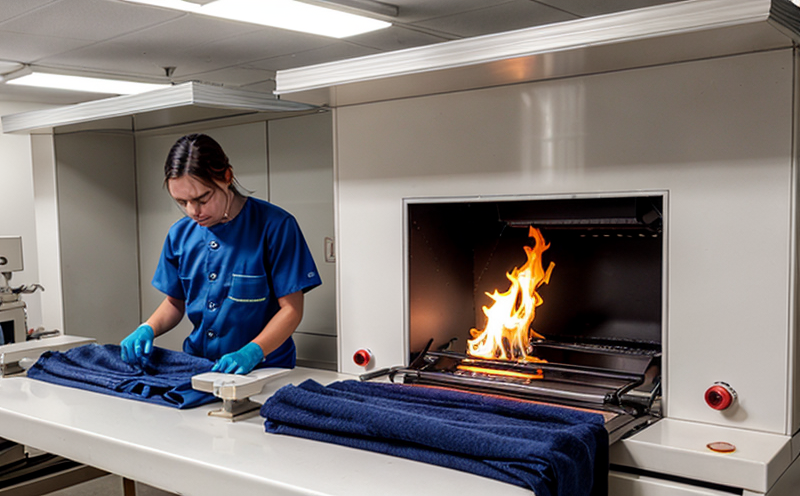Thermal Imaging during Textile Fire Testing
In the realm of fire safety testing, textiles and apparel materials are subjected to rigorous evaluation to ensure they meet stringent flammability standards. One critical technique used in this process is thermal imaging, which provides detailed insights into how a material behaves under controlled fire conditions. This section delves into the specifics of using thermal imaging during textile fire tests, exploring its significance for quality managers and compliance officers.
Thermal imaging during textile fire testing involves capturing heat signatures as fabrics or garments are exposed to flames. The process allows testers to monitor the temperature distribution across a specimen over time, which is invaluable for assessing how effectively a material resists ignition and self-extinguishes once the flame source is removed. This data helps in identifying weak points in design or manufacturing that could compromise fire safety.
The thermal imaging technique complements other traditional methods like calorimetry and cone calorimeter tests by offering real-time visual feedback on the heat transfer characteristics of textiles. This information can be crucial for product development, ensuring compliance with international standards such as ISO 13565-1:2014 (Textiles — Determination of flammability in a vertical test). By leveraging thermal imaging, manufacturers can enhance their products’ fire safety performance, thereby protecting end-users and meeting regulatory requirements.
The application of thermal imaging during textile fire testing is particularly beneficial for quality managers and compliance officers. It helps them stay ahead of evolving market demands and regulatory changes by providing precise data on material behavior under various fire scenarios. This capability ensures that products not only meet current standards but also offer enhanced protection against potential hazards.
For R&D engineers, thermal imaging offers an advanced tool for optimizing textile designs. By analyzing heat patterns during tests, they can refine fabric composition and structure to improve flame resistance. Similarly, procurement teams benefit from this technology by ensuring suppliers deliver high-quality materials that consistently pass rigorous fire safety assessments.
Applied Standards
| Applied Standard | Description |
|---|---|
| ISO 13565-1:2014 | Textiles — Determination of flammability in a vertical test. |
| ASTM E729-18 | Standard Test Method for Determining Flame Spread and Smoke Developed by Plastics Using a Thermal Analyzer. |
| EN 340:2015 | Textiles — Determination of flame spread in the horizontal position. |
| IEC 60695-11-2:2017 | Determination of the flammability characteristics of materials for use in low voltage electrical apparatus and equipment up to 1000 V AC or 1400 V DC — Part 11-2: Test method for fabrics. |
These standards provide a framework within which thermal imaging is used to assess textile performance. They ensure that the testing methodologies are consistent and reliable, enabling manufacturers to produce safe products consistently.
Quality and Reliability Assurance
- Consistent data collection for reproducible results.
- Real-time monitoring of temperature changes during fire exposure.
- Identification of material weaknesses through detailed heat distribution analysis.
- Precise determination of flame spread and smoke development characteristics.
- Comprehensive reporting that supports compliance with international standards.
The use of thermal imaging enhances the reliability and accuracy of textile fire testing. By providing continuous temperature data, it enables laboratories to capture critical moments in a specimen's response to fire, ensuring that no detail is overlooked. This level of scrutiny is essential for maintaining high-quality assurance practices and fostering customer satisfaction.
Customer Impact and Satisfaction
For quality managers, thermal imaging during textile fire testing offers a robust tool to enhance product safety. By identifying potential risks early in the development process, they can address issues before products reach market, reducing recall costs and enhancing brand reputation.
Compliance officers benefit from this technology as it streamlines the audit process by providing clear evidence of adherence to regulatory requirements. This reduces the likelihood of non-compliance fines and ensures ongoing compliance with changing standards.
R&D engineers can leverage thermal imaging to innovate more effective fire-resistant textiles, leading to safer products that meet or exceed customer expectations. Procurement teams gain confidence in their suppliers knowing that rigorous testing protocols are in place, which fosters long-term partnerships based on trust and reliability.
Ultimately, the use of thermal imaging during textile fire testing contributes to increased customer satisfaction by delivering safer, more durable garments and textiles. This aligns with broader sustainability goals and enhances overall industry standards.





